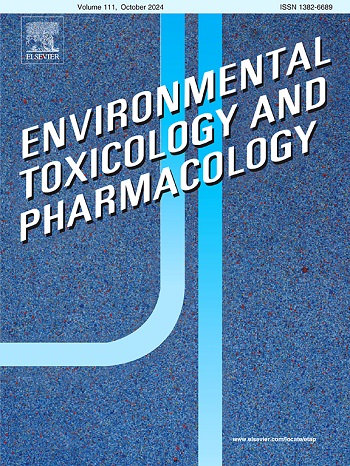The thiamethoxam-based insecticide Cruiser 350 Fs induced histopathological and oxidative stress in the stingless bee Partamona helleri (Hymenoptera: Apidae: Meliponini)
IF 4.2
3区 环境科学与生态学
Q2 ENVIRONMENTAL SCIENCES
引用次数: 0
Abstract
The stingless bee Partamona helleri plays a crucial role in pollinating both native and cultivated plants. However, the intensive use of pesticides in agriculture are contributing to the decline of its population. Thiamethoxam, a systemic neonicotinoid insecticide, acts on the nervous system, however, it can also affect other non-target insect organs. This study evaluated the sublethal effects of chronic oral exposure to a thiamethoxam formulation on the fat body and Malpighian tubules in P. helleri workers. Bees were exposed orally for seven days to sublethal concentration of thiamethoxam (0.09 ng g−1). The results revealed histopathological alterations in the fat body and Malpighian tubules, including changes in protein and carbohydrate reserves, nuclear pyknosis, cytoplasmic vacuolization, and affect lipid peroxidation in P. helleri. These findings indicate that chronic exposure of P. helleri workers to the residual concentration of thiamethoxam found in the field elicits a detoxification response in the fat body and Malpighian tubules; however, the previously reported high mortality rate suggests that these physiological responses are insufficient to mitigate the toxic effects of thiamethoxam on this pollinator.
噻虫胺类杀虫剂Cruiser 350fs诱导无刺蜜蜂的组织病理和氧化应激(膜翅目:蜂科:蜂蜂)
无刺蜜蜂在为本地和栽培植物授粉方面起着至关重要的作用。然而,农业中大量使用农药导致其数量下降。噻虫嗪是一种全身性的新烟碱类杀虫剂,作用于神经系统,但它也可以影响其他非目标昆虫器官。本研究评估了长期口服噻虫嗪制剂对黑氏弧菌工人脂肪体和马氏小管的亚致死效应。将蜜蜂口服暴露于亚致死浓度的噻虫嗪(0.09 ng g−1)中7天。结果显示,脂肪体和马尔比氏小管的组织病理学改变,包括蛋白质和碳水化合物储备的变化,核固缩,细胞质空泡化,并影响脂质过氧化。这些发现表明,长期暴露于现场发现的残留浓度噻虫嗪的黑螺旋体工人引起了脂肪体和马尔比氏小管的解毒反应;然而,先前报道的高死亡率表明,这些生理反应不足以减轻噻虫嗪对这种传粉媒介的毒性作用。
本文章由计算机程序翻译,如有差异,请以英文原文为准。
求助全文
约1分钟内获得全文
求助全文
来源期刊
CiteScore
7.00
自引率
4.70%
发文量
185
审稿时长
34 days
期刊介绍:
Environmental Toxicology and Pharmacology publishes the results of studies concerning toxic and pharmacological effects of (human and veterinary) drugs and of environmental contaminants in animals and man.
Areas of special interest are: molecular mechanisms of toxicity, biotransformation and toxicokinetics (including toxicokinetic modelling), molecular, biochemical and physiological mechanisms explaining differences in sensitivity between species and individuals, the characterisation of pathophysiological models and mechanisms involved in the development of effects and the identification of biological markers that can be used to study exposure and effects in man and animals.
In addition to full length papers, short communications, full-length reviews and mini-reviews, Environmental Toxicology and Pharmacology will publish in depth assessments of special problem areas. The latter publications may exceed the length of a full length paper three to fourfold. A basic requirement is that the assessments are made under the auspices of international groups of leading experts in the fields concerned. The information examined may either consist of data that were already published, or of new data that were obtained within the framework of collaborative research programmes. Provision is also made for the acceptance of minireviews on (classes of) compounds, toxicities or mechanisms, debating recent advances in rapidly developing fields that fall within the scope of the journal.

 求助内容:
求助内容: 应助结果提醒方式:
应助结果提醒方式:


